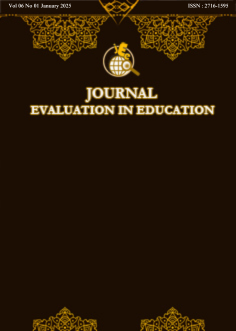Development and Implementation of a Web-Based Journal Management System to Enhance Accreditation and Quality Evaluation
Abstract
Purpose of the Study: This study aims to explore the role and importance of a dedicated journal management website in facilitating the organization, monitoring, and evaluation of journal development at Jambi University. The focus is on how this digital platform can improve journal accreditation processes and overall management efficiency.
Methodology: The research adopts a qualitative approach, utilizing focused interviews with 20 respondents from the journal management team at Jambi University. A purposive sampling method was employed to ensure that participants had relevant experience in journal management. Data were collected through in-depth interviews and analyzed to identify common themes related to the challenges and benefits of using a centralized journal management platform.
Main Findings: The findings reveal that the implementation of a dedicated journal management website is crucial in supporting the accreditation and development process. Respondents highlighted that such a platform simplifies tracking journal progress, facilitates communication and collaboration among team members, and provides an organized structure for managing evaluation and feedback. The website also enables the team to systematically monitor the quality of journals, helping them meet national and international accreditation standards more efficiently.
Novelty/Originality of the Study: This study introduces an innovative approach to managing academic journals through a specialized digital platform, addressing a critical gap in traditional journal management practices. The proposed website not only enhances administrative efficiency but also serves as a strategic tool for continuous quality improvement and collaborative evaluation, ultimately raising the university’s research profile on a broader scale.
References
[2] M. Ngafifi, “Kemajuan teknologi dan pola hidup manusia dalam perspektif sosial budaya [Technological progress and human lifestyle from a socio-cultural perspective],” J. Pembang. Pendidik. Fondasi dan Apl., vol. 2, no. 1, pp. 33–47, 2014, doi: 10.21831/jppfa.v2i1.2616.
[3] U. H. Salsabila, W. M. Lestari, R. Habibah, O. Andaresta, and D. Yulianingsih, “Pemanfaatan teknologi media pembelajaran di masa pandemi Covid-19 [Utilization of learning media technology during the Covid-19 pandemic],” Trapsila J. Pendidik. Dasar, vol. 2, no. 02, p. 1, 2020, doi: 10.30742/tpd.v2i2.1070.
[4] N. Agustian and U. H. Salsabila, “Peran teknologi pendidikan dalam pembelajaran [The role of educational technology in learning],” Islamika, vol. 3, no. 1, pp. 123–133, 2021, doi: 10.36088/islamika.v3i1.1047.
[5] Aoun, A., Ilinca, A., Ghandour, M., & Ibrahim, H. (2021). A review of Industry 4.0 characteristics and challenges, with potential improvements using blockchain technology. Computers & Industrial Engineering, 162, 107746, 2021, doi: 10.1016/j.cie.2021.107746.
[6] Javaid, M., Haleem, A., Singh, R. P., Suman, R., & Gonzalez, E. S. (2022). Understanding the adoption of Industry 4.0 technologies in improving environmental sustainability. Sustainable Operations and Computers, 3, 203-217, 2022, doi: 10.1016/j.susoc.2022.01.008.
[7] Dangi, R., Lalwani, P., Choudhary, G., You, I., & Pau, G. (2021). Study and investigation on 5G technology: A systematic review. Sensors, 22(1), 26, 2021, doi: 10.3390/s22010026.
[8] Dutta, G., Kumar, R., Sindhwani, R., & Singh, R. K. (2021). Digitalization priorities of quality control processes for SMEs: A conceptual study in perspective of Industry 4.0 adoption. Journal of Intelligent Manufacturing, 32(6), 1679-1698, 2021, doi: 10.1007/s10845-021-01783-2.
[9] Mondejar, M. E., Avtar, R., Diaz, H. L. B., Dubey, R. K., Esteban, J., Gómez-Morales, A., ... & Garcia-Segura, S. (2021). Digitalization to achieve sustainable development goals: Steps towards a Smart Green Planet. Science of The Total Environment, 794, 148539, 2021, doi: 10.1016/j.scitotenv.2021.148539.
[10] Ghobakhloo, M. (2020). Industry 4.0, digitization, and opportunities for sustainability. Journal of cleaner production, 252, 119869, 2020, doi: 10.1016/j.jclepro.2019.119869.
[11] Tuluk, A., & Yurdugül, H. (2020). Design and development of a web based dynamic assessment system to increase students' learning effectiveness. International Journal of Assessment Tools in Education, 7(4), 631-656, 2020, doi: 10.21449/ijate.730454.
[12] Piccoli, G., Rodriguez, J., Palese, B., & Bartosiak, M. L. (2020). Feedback at scale: designing for accurate and timely practical digital skills evaluation. European Journal of Information Systems, 29(2), 114-133, 2020, doi: 10.1080/0960085X.2019.1701955.
[13] Sajja, R., Sermet, Y., Cikmaz, M., Cwiertny, D., & Demir, I. (2024). Artificial intelligence-enabled intelligent assistant for personalized and adaptive learning in higher education. Information, 15(10), 596, 2024, doi: 10.3390/info15100596.
[14] Chen, C. M., Li, M. C., & Chen, Y. T. (2022). The effects of web-based inquiry learning mode with the support of collaborative digital reading annotation system on information literacy instruction. Computers & Education, 179, 104428, 2022, doi: 10.1016/j.compedu.2021.104428.
[15] M. A. Dhina, G. Hadisoebroto, S. R. Mubaroq, and I. Gustiana, “Implementation of digital performance assessment to measure pharmacy physics laboratory skills,” Momentum Phys. Educ. J., vol. 5, no. 1, pp. 65–72, 2021, doi: 10.21067/mpej.v5i1.5146.
[16] L. Sauvé, A. Fortin, C. Viger, and F. Landry, “Ineffective learning strategies: a significant barrier to post-secondary perseverance,” J. Furth. High. Educ., vol. 42, no. 2, pp. 205–222, 2018, doi: 10.1080/0309877X.2016.1224329.
[17] A. Manik, I. Salamah, and E. Susanti, “Pengaruh metode webqual 4.0 terhadap kepuasan pengguna website Politeknik Negeri Sriwijaya [The influence of the webqual 4.0 method on user satisfaction at the Sriwijaya State Polytechnic website],” J. Elektro dan Telekomun. Terap., vol. 4, no. 1, p. 477, 2017, doi: 10.25124/jett.v4i1.994.
[18] M. P. Damanik and E. H. Purwaningsih, “E-Government and its applications in local government environments (Case Study of the Quality of Information on the Website of Bengkalis Regency, Riau Province),” J. Stud. Komun. dan Media, vol. 21, no. 2, p. 151, 2017, doi: 10.31445/jskm.2017.210202.
[19] Guo, Y., Yang, Z., Yang, Z., Liu, Y. Q., Bielefield, A., & Tharp, G. (2021). The provision of patron services in Chinese academic libraries responding to the COVID-19 pandemic. Library Hi Tech, 39(2), 533-548, 2021, doi: 10.1108/LHT-04-2020-0098.
[20] Ismail, A., Kuppusamy, K. S., & Paiva, S. (2020). Accessibility analysis of higher education institution websites of Portugal. Universal Access in the Information Society, 19, 685-700, 2020, doi: 10.1007/s10209-019-00653-2.
[21] Kusumastuti, R. D., Nurmala, N., Rouli, J., & Herdiansyah, H. (2022). Analyzing the factors that influence the seeking and sharing of information on the smart city digital platform: Empirical evidence from Indonesia. Technology in Society, 68, 101876, 2022, doi: 10.1016/j.techsoc.2022.101876.
[22] Abbas, A. F., Jusoh, A., Mas’ od, A., Alsharif, A. H., & Ali, J. (2022). Bibliometrix analysis of information sharing in social media. Cogent Business & Management, 9(1), 2016556, 2022, doi: 10.1080/23311975.2021.2016556.
[23] Neri, F., Eccher, A., Rigotti, P., Girolami, I., Zaza, G., Gambaro, G., ... & Furian, L. (2021). Advantages of using a web-based digital platform for kidney preimplantation biopsies. Journal of Pathology Informatics, 12(1), 41, 2021, doi: 10.4103/jpi.jpi_23_21.
[24] Chansanam, W., Tuamsuk, K., Poonpon, K., & Ngootip, T. (2021). Development of online learning platform for Thai university students. International Journal of Information and Education Technology, 11(8), 348-355, 2021, doi: 10.18178/ijiet.2021.11.8.1534.
[25] Charalambous, A. P., Pye, A., Yeung, W. K., Leroi, I., Neil, M., Thodi, C., & Dawes, P. (2020). Tools for app-and web-based self-testing of cognitive impairment: systematic search and evaluation. Journal of medical Internet research, 22(1), e14551, 2020, doi: 10.2196/14551.
[26] M, Fitrah, Metodologi penelitian: penelitian kualitatif, tindakan kelas & studi kasus [Research methodology: qualitative research, classroom action & case study]. CV Jejak (Jejak Publisher), 2018.
[27] M. B. Miles, and A. M. Huberman, Qualitative data analysis: An expanded sourcebook. Thousand Oaks, 1994.
[28] Niam, K., Huda, M. N., Sulanam, S., & Ridwan, A. (2023). Knowledge Management Practices in Enhancing Academic Output: A Study of Indonesian Islamic Universities. Ulumuna, 27(2), 735-761, 2023, doi: 10.20414/ujis.v27i2.582.
[29] Dahnial, D. (2023). Implementation of K-Means clustering method to lecturers based on publications of National Journals and Accredited Sinta. JEECS (Journal of Electrical Engineering and Computer Sciences), 8(1), 27-40, 2023, doi: 10.54732/jeecs.v8i1.4.
[30] Mayulu, H., & Tricahyadinata, I. (2024). Accreditation Automation System to Improve the Quality of Education. INOVASI: Jurnal Ekonomi, Keuangan, dan Manajemen, 20(4), 807-813, 2024, doi: 10.30872/jinv.v20i4.2213.
[31] Aslamiyah, M. H., Istikomah, I., & Fahyuni, E. F. (2022). The Effect of School Principals' Leadership Styles on the External Quality Assurance System's Improvement. KnE Social Sciences, 193-203, 2022, doi: 10.18502/kss.v7i10.11221.
[32] Baah, R., Konovalov, O., & Tenzin, S. (2024). Effectiveness of E-Assessment in science learning: Improving the quality and efficiency of assessment in the digital era. Integrated Science Education Journal, 5(2), 74-81, 2024, doi: 10.37251/isej.v5i2.960.
[33] Zhang, W., & Bray, M. (2020). Comparative research on shadow education: Achievements, challenges, and the agenda ahead. European Journal of education, 55(3), 322-341, 2020, doi: 10.1111/ejed.12413.
[34] Goralski, M. A., & Tan, T. K. (2020). Artificial intelligence and sustainable development. The International Journal of Management Education, 18(1), 100330, 2020, doi: 10.1016/j.ijme.2019.100330.
Copyright (c) 2025 Kamid Kamid, Mukhlash Abrar, Dwi Agus Kurniawan, Eko Nuriyatman

This work is licensed under a Creative Commons Attribution 4.0 International License.
Authors who publish with this journal agree to the following terms:
- Authors retain copyright and acknowledge that the Integrated Science Education Journal is the first publisher licensed under a Creative Commons Attribution 4.0 International License.
- Authors are able to enter into separate, additional contractual arrangements for the non-exclusive distribution of the journal's published version of the work (e.g., post it to an institutional repository or publish it in a book), with an acknowledgment of its initial publication in this journal.
- Authors are permitted and encouraged to post their work online (e.g., in institutional repositories or on their website) prior to and during the submission process, as it can lead to productive exchanges and earlier and greater citation of published work.









.png)
.png)





